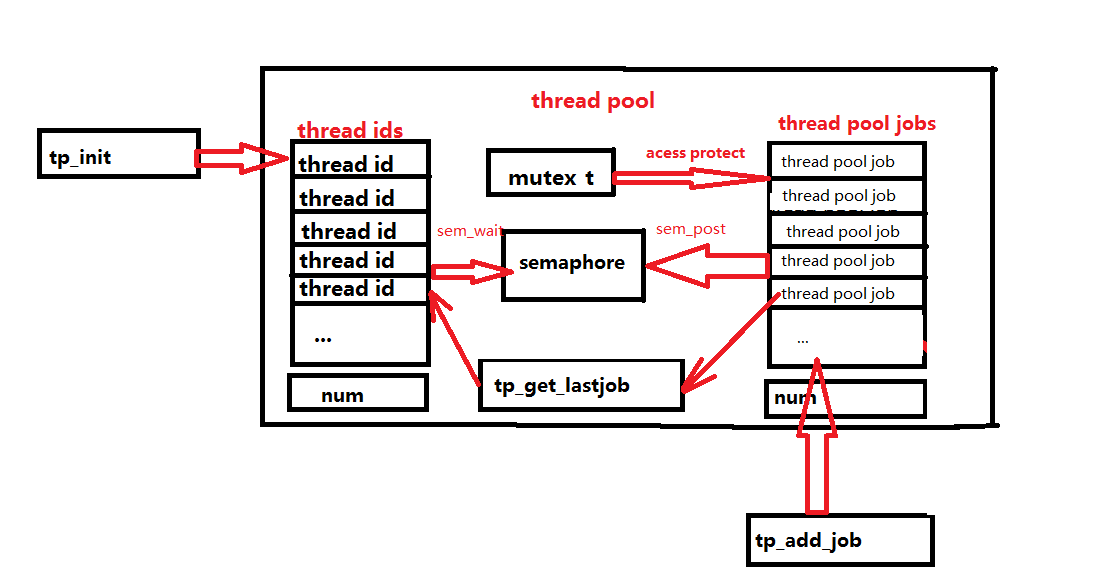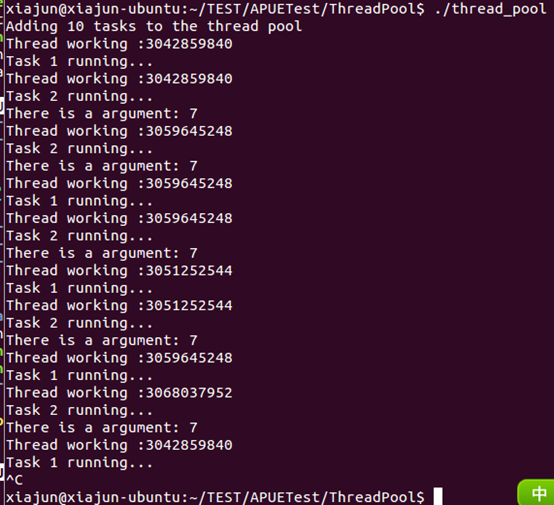出处:http://blog.csdn.net/xiajun07061225/article/details/11889423
生产者消费者编程实现,采用了线程池以及信号量技术。
线程的概念就不多说,首先说一下多线程的好处:多线程技术主要解决处理器单元内多个线程执行的问题,它可以显著减少处理器单元的闲置时间,增加处理器单元的吞吐能力。
那么为什么又需要线程池呢?
我们知道应用程序创建一个对象,然后销毁对象是很耗费资源的。创建线程,销毁线程,也是如此。因此,我们就预先生成一些线程,等到我们使用的时候在进行调度,于是,一些"池化资源"技术就这样的产生了。
一般一个简单线程池至少包含下列组成部分。
1) 线程池管理器(ThreadPoolManager):用于创建并管理线程池
2) 工作线程(WorkThread): 线程池中线程
3) 任务接口(Task):每个任务必须实现的接口,以供工作线程调度任务的执行。
4) 任务队列:用于存放没有处理的任务。提供一种缓冲机制。
图示:
图1 线程池图解
生产者消费者模型C语言代码实现:
thread_pool_pv.h:
- //线程池编程实现
- #ifndef THREAD_POOL_H
- #define THREAD_POOL_H
- #include <stdio.h>
- #include <stdlib.h>
- #include <semaphore.h>//信号量sem_t
- #include <pthread.h>
- //任务接口,线程调用的函数
- typedef void* (*FUNC)(void *arg);
- //任务数据结构
- typedef struct thread_pool_job_s{
- FUNC function;//线程调用的函数
- void *arg;//函数参数
- struct thread_pool_job_s *pre;//指向上一个节点
- struct thread_pool_job_s *next;//指向下一个节点
- }thread_pool_job;
- //工作队列
- typedef struct thread_pool_job_queue_s{
- thread_pool_job *head;//队列头指针
- thread_pool_job *tail;//队列尾指针
- int num;//任务数目
- sem_t *quene_sem;//信号量
- }thread_pool_job_queue;
- //线程池(存放消费者进程)
- typedef struct thread_pool_s{
- pthread_t *threads;//线程
- int threads_num;//线程数目
- thread_pool_job_queue *job_queue;//指向工作队列的指针
- }thread_pool;
- //typedef struct thread_data_s{
- // pthread_mutex_t *mutex_t;//互斥量
- // thread_pool *tp_p;//指向线程池的指针
- //}thread_data;
- //初始化线程池
- thread_pool* tp_init(int thread_num);
- //初始化工作队列
- int tp_job_quene_init(thread_pool *tp);
- //向工作队列中添加一个元素
- void tp_job_quene_add(thread_pool *tp,thread_pool_job *new_job);
- //向线程池中添加一个工作项
- int tp_add_work(thread_pool *tp,void *(*func_p)(void *),void *arg);
- //取得工作队列的最后个节点
- thread_pool_job* tp_get_lastjob(thread_pool *tp);
- //删除工作队列的最后个节点
- int tp_delete__lastjob(thread_pool *tp);
- //销毁线程池
- void tp_destroy(thread_pool *tp);
- //消费者线程函数
- void* tp_thread_func(thread_pool *tp);
- //生产者线程执行函数
- void* thread_func_producer(thread_pool *tp);
- #endif
thread_pool_pv.c:
- //线程池编程实现
- #include "thread_pool.h"
- //互斥量,用于对工作队列的访问
- pthread_mutex_t mutex = PTHREAD_MUTEX_INITIALIZER;
- //标记线程池是否处于可用状态
- static int tp_alive = 1;
- //初始化线程池
- thread_pool* tp_init(int thread_num){
- thread_pool *tp;
- int i;
- if(thread_num < 1)
- thread_num = 1;
- tp = (thread_pool *)malloc(sizeof(thread_pool));
- //判断内存分配是否成功
- if(NULL == tp){
- printf("ERROR:allocate memory for thread_pool failed\n");
- return NULL;
- }
- tp->threads_num = thread_num;
- //分配线程所占内存空间
- tp->threads = (pthread_t*)malloc(thread_num * sizeof(pthread_t));
- //判断内存分配是否成功
- if(NULL == tp->threads){
- printf("ERROR:allocate memory for threads in thread pool failed\n");
- return NULL;
- }
- if(tp_job_quene_init(tp))
- return NULL;
- tp->job_queue->quene_sem = (sem_t *)malloc(sizeof(sem_t));
- sem_init(tp->job_queue->quene_sem,0,0);//信号量初始化
- //初始化线程
- for(i = 0;i < thread_num;++i){
- pthread_create(&(tp->threads[i]),NULL,(void *)tp_thread_func,(void *)tp);
- }
- return tp;
- }
- //初始化工作队列
- int tp_job_quene_init(thread_pool *tp){
- tp->job_queue = (thread_pool_job_queue *)malloc(sizeof(thread_pool_job_queue));
- if(NULL == tp->job_queue){
- return -1;
- }
- tp->job_queue->head = NULL;
- tp->job_queue->tail = NULL;
- tp->job_queue->num = 0;
- return 0;
- }
- //线程函数
- void* tp_thread_func(thread_pool *tp){
- FUNC function;
- void *arg_buf;
- thread_pool_job *job_p;
- while(tp_alive){
- //线程阻塞,等待信号量
- if(sem_wait(tp->job_queue->quene_sem)){
- printf("thread waiting for semaphore....\n");
- exit(1);
- }
- if(tp_alive){
- pthread_mutex_lock(&mutex);
- job_p = tp_get_lastjob(tp);
- if(NULL == job_p){
- pthread_mutex_unlock(&mutex);
- continue;
- }
- function = job_p->function;
- arg_buf = job_p->arg;
- if(tp_delete__lastjob(tp))
- return;
- pthread_mutex_unlock(&mutex);
- //运行指定的线程函数
- printf("consumer...get a job from job quene and run it!\n");
- function(arg_buf);
- free(job_p);
- }
- else
- return;
- }
- return;
- }
- //向工作队列中添加一个元素
- void tp_job_quene_add(thread_pool *tp,thread_pool_job *new_job){
- new_job->pre = NULL;
- new_job->next = NULL;
- thread_pool_job *old_head_job = tp->job_queue->head;
- if(NULL == old_head_job){
- tp->job_queue->head = new_job;
- tp->job_queue->tail = new_job;
- }
- else{
- old_head_job->pre = new_job;
- new_job->next = old_head_job;
- tp->job_queue->head = new_job;
- }
- ++(tp->job_queue->num);
- sem_post(tp->job_queue->quene_sem);
- }
- //取得工作队列的最后一个节点
- thread_pool_job* tp_get_lastjob(thread_pool *tp){
- return tp->job_queue->tail;
- }
- //删除工作队列的最后个节点
- int tp_delete__lastjob(thread_pool *tp){
- if(NULL == tp)
- return -1;
- thread_pool_job *last_job = tp->job_queue->tail;
- if(0 == tp->job_queue->num){
- return -1;
- }
- else if(1 == tp->job_queue->num){
- tp->job_queue->head = NULL;
- tp->job_queue->tail = NULL;
- }
- else{
- last_job->pre->next = NULL;
- tp->job_queue->tail = last_job->pre;
- }
- //修改相关变量
- --(tp->job_queue->num);
- return 0;
- }
- //向线程池中添加一个工作项
- int tp_add_work(thread_pool *tp,void *(*func_p)(void *),void *arg){
- thread_pool_job *new_job = (thread_pool_job *)malloc(sizeof(thread_pool_job));
- if(NULL == new_job){
- printf("ERROR:allocate memory for new job failed!\n");
- exit(1);
- }
- new_job->function = func_p;
- new_job->arg = arg;
- pthread_mutex_lock(&mutex);
- tp_job_quene_add(tp,new_job);
- pthread_mutex_unlock(&mutex);
- }
- //销毁线程池
- void tp_destroy(thread_pool *tp){
- int i;
- tp_alive = 0;
- //等待线程运行结束
- //sleep(10);
- for(i = 0;i < tp->threads_num;++i){
- pthread_join(tp->threads[i],NULL);
- }
- free(tp->threads);
- if(sem_destroy(tp->job_queue->quene_sem)){
- printf("ERROR:destroy semaphore failed!\n");
- }
- free(tp->job_queue->quene_sem);
- //删除job队列
- thread_pool_job *current_job = tp->job_queue->tail;
- while(tp->job_queue->num){
- tp->job_queue->tail = current_job->pre;
- free(current_job);
- current_job = tp->job_queue->tail;
- --(tp->job_queue->num);
- }
- tp->job_queue->head = NULL;
- tp->job_queue->tail = NULL;
- }
- //自定义线程执行函数
- void* thread_func1(){
- printf("Task1 running...by Thread :%u\n",(unsigned int)pthread_self());
- }
- //自定义线程执行函数
- void* thread_func2(){
- printf("Task2 running...by Thread :%u\n",(unsigned int)pthread_self());
- }
- //生产者线程执行函数
- void* thread_func_producer(thread_pool *tp){
- while(1){
- printf("producer...add a job(job1) to job quene!\n");
- tp_add_work(tp,(void*)thread_func1,NULL);
- sleep(1);
- printf("producer...add a job(job2) to job quene!\n");
- tp_add_work(tp,(void*)thread_func2,NULL);
- }
- }
- int main(){
- thread_pool *tp = tp_init(5);
- int i;
- int arg = 7;
- pthread_t producer_thread_id;//生产者线程ID
- pthread_create(&producer_thread_id,NULL,(void *)thread_func_producer,(void *)tp);
- pthread_join(producer_thread_id,NULL);
- tp_destroy(tp);
- return 0;
- }
运行结果:

























 被折叠的 条评论
为什么被折叠?
被折叠的 条评论
为什么被折叠?








